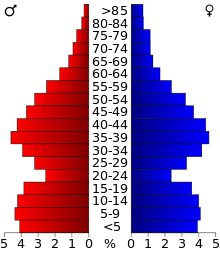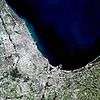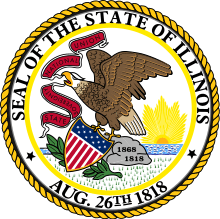Kendall County, Illinois
Kendall County is a county in the U.S. state of Illinois, within the Chicago metropolitan area. According to the 2010 census, it has a population of 114,736.[1] Its county seat is Yorkville,[2] and its most populous municipality is Oswego.
Kendall County | |
|---|---|
Kendall County Courthouse | |
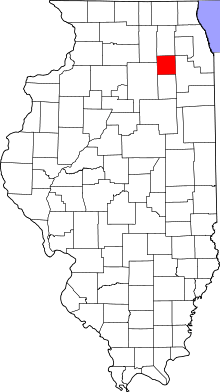 Location within the U.S. state of Illinois | |
 Illinois's location within the U.S. | |
| Coordinates: 41°35′N 88°26′W | |
| Country | |
| State | |
| Founded | 1841 |
| Named for | Amos Kendall |
| Seat | Yorkville |
| Largest village | Oswego |
| Area | |
| • Total | 322 sq mi (830 km2) |
| • Land | 320 sq mi (800 km2) |
| • Water | 2.0 sq mi (5 km2) 0.61% |
| Population (2010) | |
| • Total | 114,736 |
| • Estimate (2019) | 128,990 |
| • Density | 360/sq mi (140/km2) |
| Time zone | UTC−6 (Central) |
| • Summer (DST) | UTC−5 (CDT) |
| Congressional districts | 11th, 14th |
| Website | www |
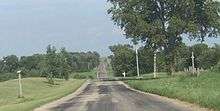
Kendall County is part of the Chicago-Naperville-Elgin, IL-IN-WI Metropolitan Statistical Area. It was the fastest-growing county in the United States between 2000 and 2010.[3]
History
Kendall County was formed in 1841 out of LaSalle and Kane Counties.
The county is named after Amos Kendall,[4] who was the editor of the Frankfort, Kentucky, newspaper, and went on to be an important advisor to President Andrew Jackson. Kendall became the U.S. Postmaster General in 1835.
 Kendall County at the time of its creation in 1841
Kendall County at the time of its creation in 1841
Geography
According to the U.S. Census Bureau, the county has an area of 322 square miles (830 km2), of which 320 square miles (830 km2) are land and 2.0 square miles (5.2 km2) (0.6%) are covered by water.[5]
Kendall County is a small but rapidly growing county that has the majority of its population in the northeast, and along the Fox River (the only river in the county), which runs through the county's northwestern section. Many new subdivisions have been constructed in this county, which has produced considerable population growth. Southern Kendall still remains largely agricultural. Kendall County has two primary ranges of low-lying hills formed by what is known as an end moraine. Ransom, the more predominant of the two moraines, runs through the west and north-central part of the county. This moraine has created elevations over 800 feet (240 m), in contrast to elevations in southern Kendall County that drop to the lower 500-foot (150 m) range. Minooka, the other major end moraine ridge in Kendall County, runs along its entire eastern border with Will County. The two moraines intersect at almost a right angle in the township of Oswego. The county's only designated state park is Silver Springs State Fish and Wildlife Area.
Climate and weather
| Yorkville, Illinois | ||||||||||||||||||||||||||||||||||||||||||||||||||||||||||||
|---|---|---|---|---|---|---|---|---|---|---|---|---|---|---|---|---|---|---|---|---|---|---|---|---|---|---|---|---|---|---|---|---|---|---|---|---|---|---|---|---|---|---|---|---|---|---|---|---|---|---|---|---|---|---|---|---|---|---|---|---|
| Climate chart (explanation) | ||||||||||||||||||||||||||||||||||||||||||||||||||||||||||||
| ||||||||||||||||||||||||||||||||||||||||||||||||||||||||||||
| ||||||||||||||||||||||||||||||||||||||||||||||||||||||||||||
In recent years, average temperatures in the county seat of Yorkville have ranged from a low of 10 °F (−12 °C) in January to a high of 84 °F (29 °C) in July, although a record low of −26 °F (−32 °C) was recorded in January 1985 and a record high of 111 °F (44 °C) was recorded in July 1936. Average monthly precipitation ranged from 1.52 inches (39 mm) in February to 4.39 inches (112 mm) in July.[6]
Major highways






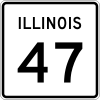


Adjacent counties
- DeKalb County - northwest
- Kane County - north
- DuPage County - northeast
- Will County - east
- Grundy County - south
- LaSalle County - west
Demographics
| Historical population | |||
|---|---|---|---|
| Census | Pop. | %± | |
| 1850 | 7,730 | — | |
| 1860 | 13,074 | 69.1% | |
| 1870 | 12,399 | −5.2% | |
| 1880 | 13,083 | 5.5% | |
| 1890 | 12,106 | −7.5% | |
| 1900 | 11,467 | −5.3% | |
| 1910 | 10,777 | −6.0% | |
| 1920 | 10,074 | −6.5% | |
| 1930 | 10,555 | 4.8% | |
| 1940 | 11,105 | 5.2% | |
| 1950 | 12,115 | 9.1% | |
| 1960 | 17,540 | 44.8% | |
| 1970 | 26,374 | 50.4% | |
| 1980 | 37,202 | 41.1% | |
| 1990 | 39,413 | 5.9% | |
| 2000 | 54,544 | 38.4% | |
| 2010 | 114,736 | 110.4% | |
| Est. 2019 | 128,990 | [7] | 12.4% |
| U.S. Decennial Census[8] 1790-1960[9] 1900-1990[10] 1990-2000[11] 2010-2019[1] | |||
As of the 2010 United States Census, 114,736 people, 38,022 households, and 30,067 families were residing in the county.[12] The population density was 358.2 inhabitants per square mile (138.3/km2). The 40,321 housing units averaged 125.9 per square mile (48.6/km2).[5] The racial makeup of the county was 83.6% White, 5.7% African American, 3.0% Asian, 0.3% Native American, 5.0% from other races, and 2.3% from two or more races. Those of Hispanic or Latino origin made up 15.6% of the population.[12] In terms of ancestry, 28.0% were German, 16.0% were Irish, 9.5% were Polish, 9.4% were Italian, 7.5% were English, and 3.2% were American.[13]
Of the 38,022 households, 47.9% had children under the age of 18 living with them, 65.8% were married couples living together, 9.2% had a female householder with no husband present, 20.9% were not families, and 16.4% of all households were made up of individuals. The average household size was 3.01, and the average family size was 3.41. The median age was 32.9 years.[12]
The county's median household income was $79,897 and its median family income was $87,309. Males had a median income of $64,048 versus $42,679 for females. The county's per capita income was $30,565. About 2.9% of families and 3.9% of the population were below the poverty line, including 4.6% of those under age 18 and 3.4% of those age 65 or over.[14]
Kendall County was listed as the fastest-growing county in the US from 2000 to 2009, experiencing a population growth rate of 110.4% in this period.[15] The reason for this growth is heavy suburbanization from the metropolitan Chicago area.
Communities
Villages
- Lisbon
- Millbrook
- Millington (mostly)
- Minooka (mostly)
- Montgomery (part)
- Newark
- Oswego
- Plainfield (part)
- Plattville
Census-designated place
Other unincorporated communities
- Bristol
- Helmar
- Little Rock
Townships
The county is an 18-mile (29 km) square, which is divided up into 9 townships. Each township is divided into 36 one-mile-square sections, except that the Fox River is used as a township border, resulting in Bristol being the smallest township with the extra area being assigned to Oswego and Kendall Townships. Two exceptions to the section grid reflect Indian land grants under the Treaty of Prairie du Chien in 1829: the Mo-Ah-Way Reservation in Oswego Township and the Waish-Kee-shaw Reservation in Na-Au-Say Township. These areas were eventually sold to European settlers.[16]
Government
(As of December 2016)
County board members run in two districts. All other officers run county-wide:
- County Board Members: Judy Gilmour, Matthew G. Prochaska, Scott Gengler, Audra Hendrix, Elizabeth Flowers, Robyn Vickers, Amy Cesich, Scott R. Gryder, Matt Kellogg, Tony Giles
- County Board Chairman – Scott R. Gryder
- Forest Preserve President – Judy Gilmour
- Clerk of the Circuit Court – Robyn Ingemunson
- Coroner – Jacquie Purcell
- County Clerk and Recorder – Debbie Gillette
- Sheriff – Dwight Baird
- State's Attorney – Eric Weis
- Treasurer – Jill Ferko
Politics
Kendall County's political history is typical of the “collar counties” and more generally of Yankee-settled Northern Illinois. In its early elections, Kendall was a stronghold of the Free Soil Party and was one of nine Illinois counties that gave a plurality to Free Soil nominee and former Democratic President Martin van Buren in the 1848 presidential election. Its Yankee population made it natural that Kendall would turn into a Republican stronghold following the creation of that party in 1854, and indeed Kendall County was rock-ribbed Republican for the following 150 years.
Between the 1856 and 2004 elections, the only time Kendall County did not give a plurality to the GOP Presidential nominee was in 1912 when the Republican Party was mortally divided and Progressive Party candidate Theodore Roosevelt won 57.56% of the county's vote against conservative incumbent President William Howard Taft. Moreover, only one Democratic Presidential candidate – Franklin Delano Roosevelt in 1932 and 1936 – ever cracked 40% of Kendall County's vote during this span of 38 presidential elections.
Since the 1990s, the gradual shift of power within the Republican Party towards Southern Evangelicals has meant that Kendall, like the other “collar counties”, has trended Democratic. Illinois native Barack Obama became the first Democrat to carry the county since Franklin Pierce in 1852. Obama did not repeat this feat against Mitt Romney in 2012, nor did Hillary Clinton defeat Donald Trump in 2016.
| Year | Republican | Democratic | Third parties |
|---|---|---|---|
| 2016 | 46.2% 24,961 | 46.0% 24,884 | 7.8% 4,210 |
| 2012 | 50.7% 24,047 | 47.4% 22,471 | 1.9% 900 |
| 2008 | 45.8% 21,380 | 53.0% 24,742 | 1.3% 609 |
| 2004 | 60.8% 19,776 | 38.4% 12,497 | 0.8% 254 |
| 2000 | 60.1% 13,688 | 37.1% 8,444 | 2.8% 637 |
| 1996 | 50.7% 8,958 | 36.8% 6,499 | 12.5% 2,215 |
| 1992 | 46.3% 8,521 | 29.5% 5,423 | 24.2% 4,462 |
| 1988 | 70.6% 10,653 | 28.8% 4,347 | 0.6% 84 |
| 1984 | 73.8% 10,872 | 25.7% 3,789 | 0.5% 69 |
| 1980 | 70.0% 10,028 | 21.9% 3,143 | 8.1% 1,156 |
| 1976 | 67.5% 9,011 | 31.5% 4,202 | 1.0% 136 |
| 1972 | 78.7% 9,373 | 21.2% 2,525 | 0.2% 19 |
| 1968 | 70.5% 7,184 | 21.9% 2,228 | 7.7% 786 |
| 1964 | 62.5% 5,710 | 37.5% 3,430 | |
| 1960 | 72.6% 5,975 | 27.3% 2,242 | 0.1% 11 |
| 1956 | 78.2% 5,057 | 21.7% 1,407 | 0.1% 7 |
| 1952 | 77.1% 4,982 | 22.8% 1,476 | 0.1% 3 |
| 1948 | 71.8% 3,925 | 27.7% 1,517 | 0.5% 27 |
| 1944 | 70.6% 4,022 | 29.4% 1,673 | 0.1% 6 |
| 1940 | 67.8% 4,200 | 31.9% 1,978 | 0.3% 18 |
| 1936 | 54.9% 3,138 | 41.5% 2,374 | 3.6% 208 |
| 1932 | 52.8% 2,749 | 46.0% 2,398 | 1.2% 62 |
| 1928 | 75.5% 3,589 | 24.3% 1,154 | 0.2% 9 |
| 1924 | 79.7% 3,513 | 9.8% 432 | 10.5% 464 |
| 1920 | 88.0% 3,459 | 11.2% 439 | 0.8% 33 |
| 1916 | 75.4% 3,316 | 22.9% 1,008 | 1.7% 75 |
| 1912 | 20.1% 534 | 20.0% 531 | 59.8% 1,586 |
| 1908 | 73.9% 1,948 | 21.1% 556 | 5.1% 133 |
| 1904 | 78.8% 2,120 | 15.7% 423 | 5.4% 146 |
| 1900 | 72.0% 2,121 | 24.2% 713 | 3.7% 110 |
| 1896 | 71.5% 2,128 | 26.0% 774 | 2.5% 74 |
| 1892 | 59.5% 1,691 | 29.8% 848 | 10.7% 305 |
Property values
Kendall County was the fastest growing county in the US, more than doubling in population between the 2000 and 2010 censuses.[18]
All five Kendall County communities analyzed saw their real home prices fall dramatically from 2007 to 2015, from a low of 17 percent in Montgomery to a high of 44 percent in Plano. Minooka and Oswego both saw their home values fall 34 percent. In Yorkville, they fell 36 percent.[18]
Education
- Lisbon Community Consolidated School District 90
- Newark Community Consolidated School District 66
- Newark Community High School District 18
- Oswego Community Unit School District 308
- Plano Community Unit School District 88
- Yorkville Community Unit School District 115
- School District #101
- School District #201
- School District #202
- School District #429
- School District #430 (Sandwich Community School District #430)
The northern half of the county is in Community College District 516 and is served by Waubonsee Community College in Sugar Grove, Aurora, and Plano. The southern half is in Community College District 525 and is served by Joliet Junior College in Joliet.[19]
In popular culture
Locations within and around the City of Plano were stand-ins for Clark Kent's hometown of Smallville, Kansas in the 2013 film Man of Steel as well as the 2016 film Batman v. Superman: Dawn of Justice. Plano has also been used in the film Witless Protection, with both films having been filmed in Plano's historic downtown area. Filming has also taken place south of Plano at the Farnsworth House, a modern architectural landmark for documentaries and commercials.
References
- Specific
- "State & County QuickFacts". United States Census Bureau. Archived from the original on June 6, 2011. Retrieved July 6, 2014.
- "Find a County". National Association of Counties. Archived from the original on May 31, 2011. Retrieved June 7, 2011.
- "Population Distribution and Change: 2000 to 2010" (PDF). United States Census Bureau. March 2011. p. 9. Archived (PDF) from the original on February 28, 2017. Retrieved March 26, 2011.
- Gannett, Henry (1905). The Origin of Certain Place Names in the United States. Govt. Print. Off. pp. 173.
- "Population, Housing Units, Area, and Density: 2010 - County". United States Census Bureau. Archived from the original on February 12, 2020. Retrieved July 12, 2015.
- "Monthly Averages for Yorkville, Illinois". The Weather Channel. Archived from the original on October 23, 2012. Retrieved January 27, 2011.
- "Population and Housing Unit Estimates". Retrieved May 21, 2020.
- "U.S. Decennial Census". United States Census Bureau. Archived from the original on April 26, 2015. Retrieved July 6, 2014.
- "Historical Census Browser". University of Virginia Library. Archived from the original on August 11, 2012. Retrieved July 6, 2014.
- "Population of Counties by Decennial Census: 1900 to 1990". United States Census Bureau. Archived from the original on April 24, 2014. Retrieved July 6, 2014.
- "Census 2000 PHC-T-4. Ranking Tables for Counties: 1990 and 2000" (PDF). United States Census Bureau. Archived (PDF) from the original on December 18, 2014. Retrieved July 6, 2014.
- "DP-1 Profile of General Population and Housing Characteristics: 2010 Demographic Profile Data". United States Census Bureau. Archived from the original on February 13, 2020. Retrieved July 12, 2015.
- "DP02 SELECTED SOCIAL CHARACTERISTICS IN THE UNITED STATES – 2006-2010 American Community Survey 5-Year Estimates". United States Census Bureau. Archived from the original on February 13, 2020. Retrieved July 12, 2015.
- "DP03 SELECTED ECONOMIC CHARACTERISTICS – 2006-2010 American Community Survey 5-Year Estimates". United States Census Bureau. Archived from the original on February 13, 2020. Retrieved July 12, 2015.
- "2010 US Census Brief" (PDF). Archived (PDF) from the original on February 28, 2017. Retrieved May 8, 2012.
- "Place Names & Geographical Features of Kendall County - Kendall County ILGenWeb". kendallkin.org. Archived from the original on October 18, 2013.
- Leip, David. "Dave Leip's Atlas of U.S. Presidential Elections". uselectionatlas.org. Archived from the original on March 23, 2018.
- "Analysis: Kendall County home prices wilt under growing property tax bills". Will County Gazette. April 9, 2017. Retrieved March 22, 2018.
- retrieved 2007-02-13 Archived 2006-12-08 at the Wayback Machine
- General
- Forstall, Richard L. (editor) (1996). Population of states and counties of the United States: 1790 to 1990 : from the twenty-one decennial censuses. United States Department of Commerce, Bureau of the Census, Population Division. ISBN 0-934213-48-8.CS1 maint: extra text: authors list (link)
